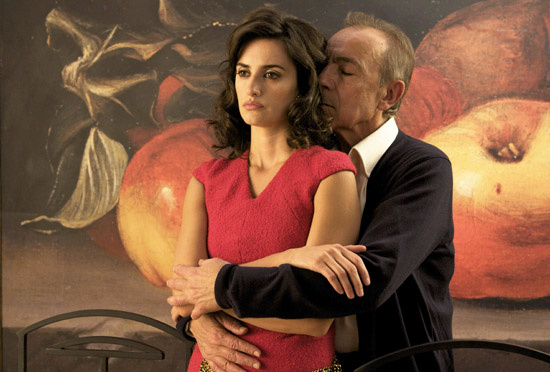About twenty years ago, Pedro Almodovar started taking photos of the posters for his films on bus stops, and anywhere else around Madrid where they would appear behind glass, thus recording, within the frame of his camera lens, the reflection of the city upon the image of his film. It was around the same time that he started to make a series of films about film making, and featuring film-makers amongst the principal characters.
His latest film, Broken Embraces, also contains a film within a film. And the film within a film in this instance, Almodovar has freely admitted, is based on his own international breakthrough, 1989’s Women on the Verge of a Nervous Breakdown — itself a film whose principal characters work in film, as voice-over actors. This Russian doll-like structure is further emphasized by the fact that the plot of Broken Embraces concerns not just the making of a film, but its remaking: it’s re-edited fourteen years after its initial cut was ruined by a jealous producer.
Though Broken Embraces contains several other themes that will be familiar to Almodovar fans — adultery, homosexuality, family secrets, prostitution, drugs and strong, noble women — it nonetheless represents a departure; the director of melodramas flirts here with tropes from the film noir genre. Alberto Iglesias’s music recalls neo-noirs like The Last Seduction, Penelope Cruz’s femme fatale recalls Gilda, and the image of her in a puffed up blonde wig that forms the publicity image for the film, and the film within a film (but otherwise scarcely features in either) is pure David Lynch. Likewise, Mateo Blanco (Lluis Homar), the director of the film within a film, is also making a departure, from his usual drama films to a comedy.

Not only does Broken Embraces double itself and repeat the earlier Women on the Verge of a Nervous Breakdown, it’s also a film concerned with doubles and with repetition — whether in Ernesto Martel Jr’s duplication of his father’s obsessive behaviour or in the figure of the two main characters, themselves doubles with two names apiece. And like much of Almodovar’s previous work, it’s also a film about duplicity, and specfically the duplicity of women — the symbol of which, as in Shakespeare’s tragedies, is make-up. This isomorphism is signposted by the scene in which Cruz’s Lena, after making love with Ernesto Martel, goes to the bathroom and looks disgusted at herself in the mirror, before applying make-up in preparation for going back to his side as his dutiful and devoted partner.
Almodovar is often celebrated, admittedly mostly by male writers, as a director of ‘women’s pictures’ in the vein of Cukor or Fassbinder; a director who understands, and whose films portray, "real women" in "real life." The truth, however, is that there are really only two types of women for Almodovar, as in the old cliche: mothers and whores (typified in Broken Embraces by Judit and Lena). The oscillation between these two archetypes is the only space for development open to Almodovar’s female characters — take Tie Me Up! Tie Me Down!, in which Antonio Banderas’s former mental patient finally seduces the ex-prostitute Marina by appealing to her deeper maternal nature, the eternal feminine beneath her tough exterior.
But if Almodovar’s characterisation fails to convince, he is at least becoming an excellent stylist. From the explosive colours and outrageous set pieces of his early-80s films through the glossy dramas of the nineties, it’s clear that the director is currently working with a far richer palette — a fact emphasized here through the device of a film within a film shot in much the way he might have a decade and a half ago. Broken Embraces is a most assured film, full of little directorial flourishes such as the montage sequence of X-rays backed by spanish guitar arpeggios.
Everything about this film seduces you and draws you deeper into its labyrinthine plot. At its core, however, there is a certain essential shallowness, laid bare in the absence of the manic energy and outrageous set pieces of his earlier work. In a sense, Almodovar the autodidact has been making the same film over and over again for the last 20 years; now that he has built up the authority, the command of style and technique to finally make that film just right, he’s lost the initial impulse that gave it such life in the first place. Still, as Mateo Blanco says at the end of Broken Embraces: "A film must be finished — even if must be finished blind."


